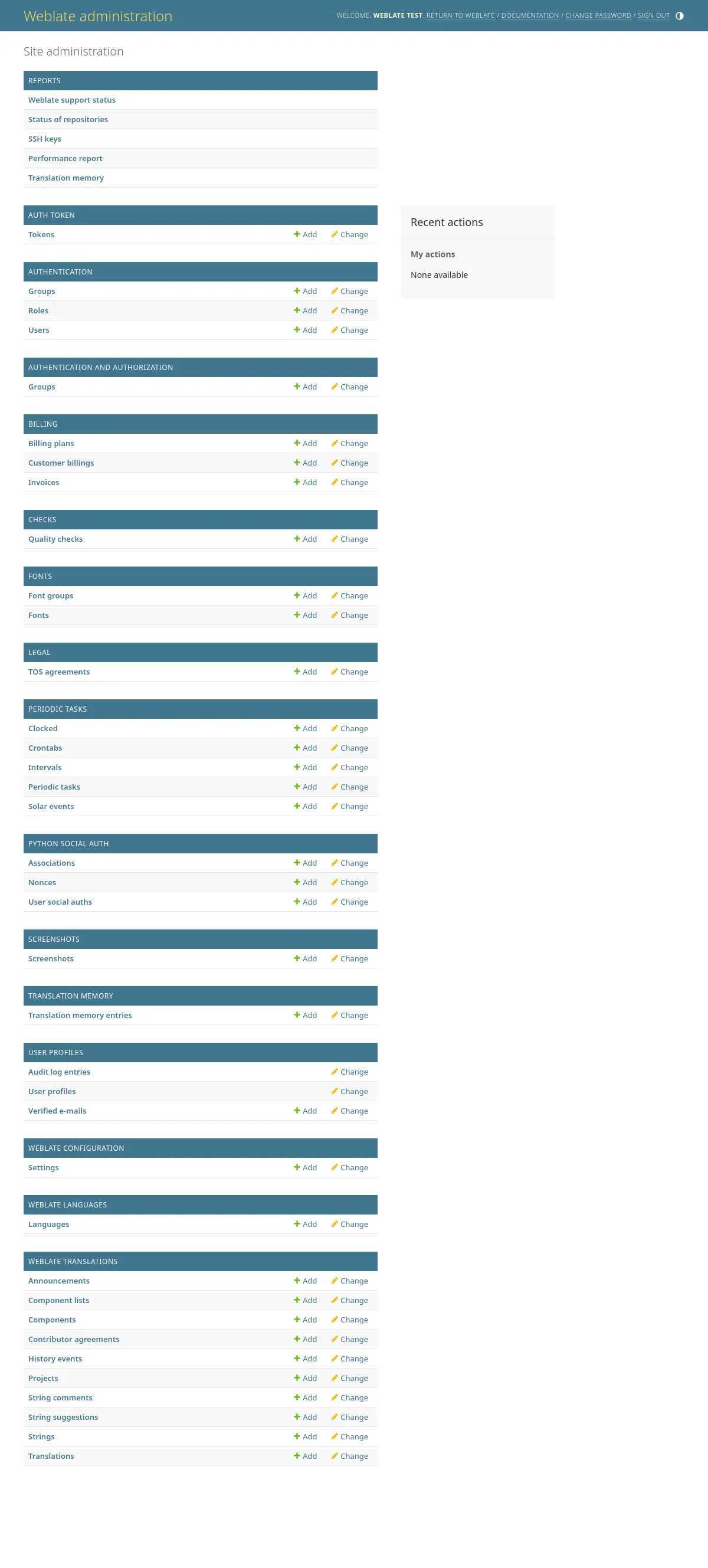Interface de gerenciamento¶
A interface de gerenciamento oferece configurações de administração sob a URL /manage/. Está disponível para usuários que se inscrevem com privilégios administrativos, acessíveis usando o ícone da chave inglesa no canto superior direito:

Ela inclui uma visão geral básica do seu Weblate:
Status de suporte, veja Obtendo suporte para o Weblate
Backups, veja Fazendo backup e movendo o Weblate
Memória de tradução compartilhada, veja Memória de tradução
Relatório de desempenho to review Weblate health and length of Celery queues
Gerenciamento de chaves SSH, veja Repositórios SSH
Visão geral de alertas para todos os componentes, veja Alertas de componente de tradução
Users and teams, see Site-wide access control
Configure Sugestões automáticas.
Configure site-wide addons, see Extensões.
Relatório de desempenho¶
This page provides an overview of Weblate configuration and performance status.
Configuration errors indicate issues present in your environment. It covers missing optional dependencies (see Dependências Python), configuration issues or delayed processing of background tasks (see Tarefas de fundo usando Celery).
System checks lists possible configuration issues. These can be
silenced using SILENCED_SYSTEM_CHECKS, see also
Deployment checklist.
Celery queues provides overview of Celery queues. These typically
should be close to zero. The same can be obtained on the command line using
celery_queues.
System encoding should list UTF-8 encoding in all processes.
This needs to be configured in your system, see Codificação e localidades do sistema.
Connectivity shows latencies to the database, cache, and Celery. This might be useful to diagnose connectivity issues.
Appearance customization¶
Adicionado na versão 4.4.
Nota
The colors are currently used in both dark and light theme, so be careful when choosing them.
Colors, fonts, and page appearance can be customized here.
If you are looking for more customization, see Personalizando o Weblate.
A interface administrativa do Django¶
Aviso
Use com cuidado, pois esta é uma interface de baixo nível. Você não deve precisar dele na maioria dos casos, pois a maioria das coisas pode ser acessada confortavelmente por meio da interface do usuário ou API do Weblate.
Aqui você pode gerenciar objetos armazenados no banco de dados, tais como usuários, traduções e outras configurações:

Na seção Relatórios, você pode verificar o status de seu site, ajustá-lo para produção ou gerenciar chaves SSH usadas para acessar Acessando repositórios.
Gerencie objetos de banco de dados sob qualquer uma das seções. A mais interessante é provavelmente Traduções do Weblate, onde você pode gerenciar projetos traduzíveis, veja Configuração de projeto e Configuração de componente.
Idiomas do Weblate detém as definições de idiomas, explicado melhor em Definições de idioma.
Adicionando um projeto¶
A adição de um projeto serve como contêiner para todos os componentes. Normalmente você cria um projeto para um software, ou livro (Veja Configuração de projeto para informações sobre parâmetros individuais):

Ver também
Componentes bilíngues¶
Uma vez adicionado um projeto, os componentes de tradução podem ser adicionados a ele. (Ver Configuração de componente para obter informações sobre parâmetros individuais):

Componentes monolíngues¶
Para facilitar a tradução destes, forneça um arquivo de modelo contendo o mapeamento de IDs de mensagem para seu respectivo idioma fonte (geralmente inglês). (Ver Configuração de componente para obter informações sobre parâmetros individuais):
